Creating a private backyard sanctuary doesn't require expensive renovations or major construction projects. Whether you're dealing with nosy neighbors, busy streets, or simply want to establish intimate outdoor spaces, smart privacy solutions can transform your yard into a secluded retreat. From natural green barriers and living walls to stylish screening systems and creative DIY projects, numerous approaches can enhance your outdoor privacy while adding aesthetic value. Modern homeowners increasingly seek versatile privacy options that complement their existing landscape design while providing functional screening. These carefully curated privacy ideas offer solutions for every budget, style preference, and yard configuration, ensuring you can enjoy peaceful outdoor moments.
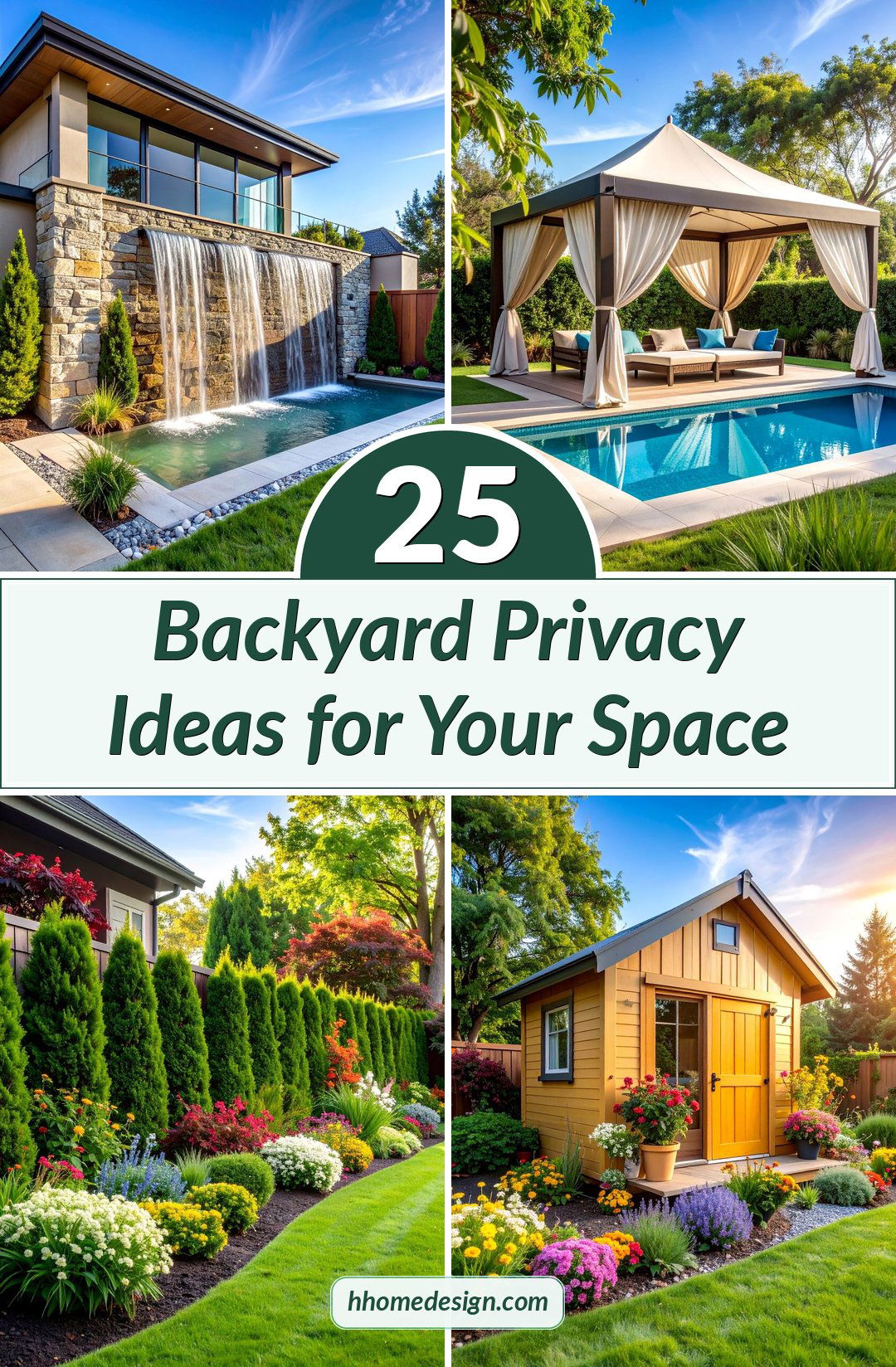
1. Traditional Wood Privacy Fence with Lattice Topper
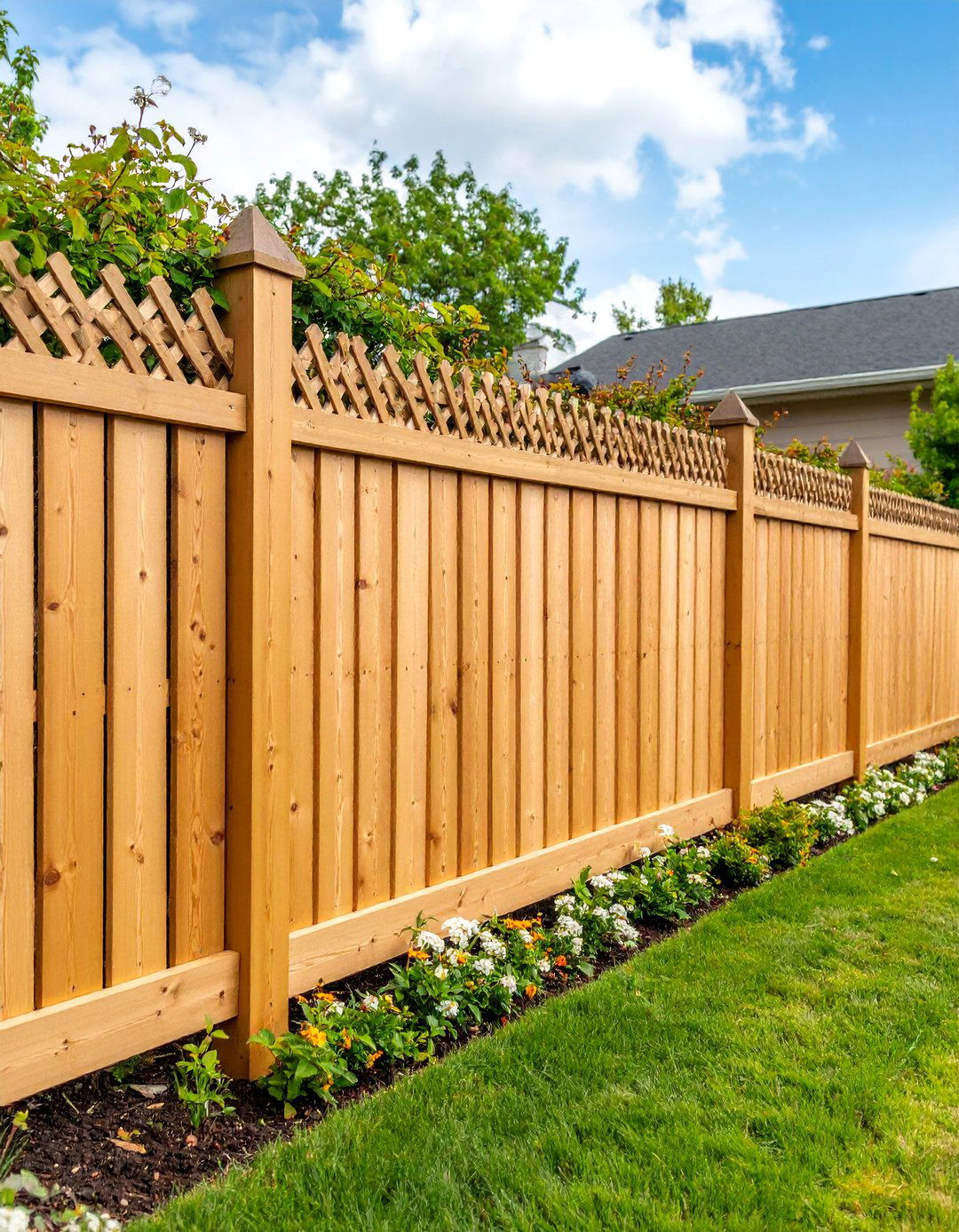
A classic wooden privacy fence creates immediate, year-round seclusion for your entire backyard perimeter. Constructed with vertical cedar or pressure-treated lumber boards, this solid barrier effectively blocks views while establishing clear property boundaries. Adding decorative lattice panels along the top softens the imposing appearance and allows filtered light to pass through. The lattice section can support climbing plants like clematis or morning glories, creating a living crown that enhances the fence's natural beauty. Choose horizontal board arrangements for a contemporary look, or stick with traditional vertical slats for timeless appeal. Staining or painting the fence in complementary colors helps integrate the structure with your home's exterior design and surrounding landscape features.
2. Bamboo Screen Paradise
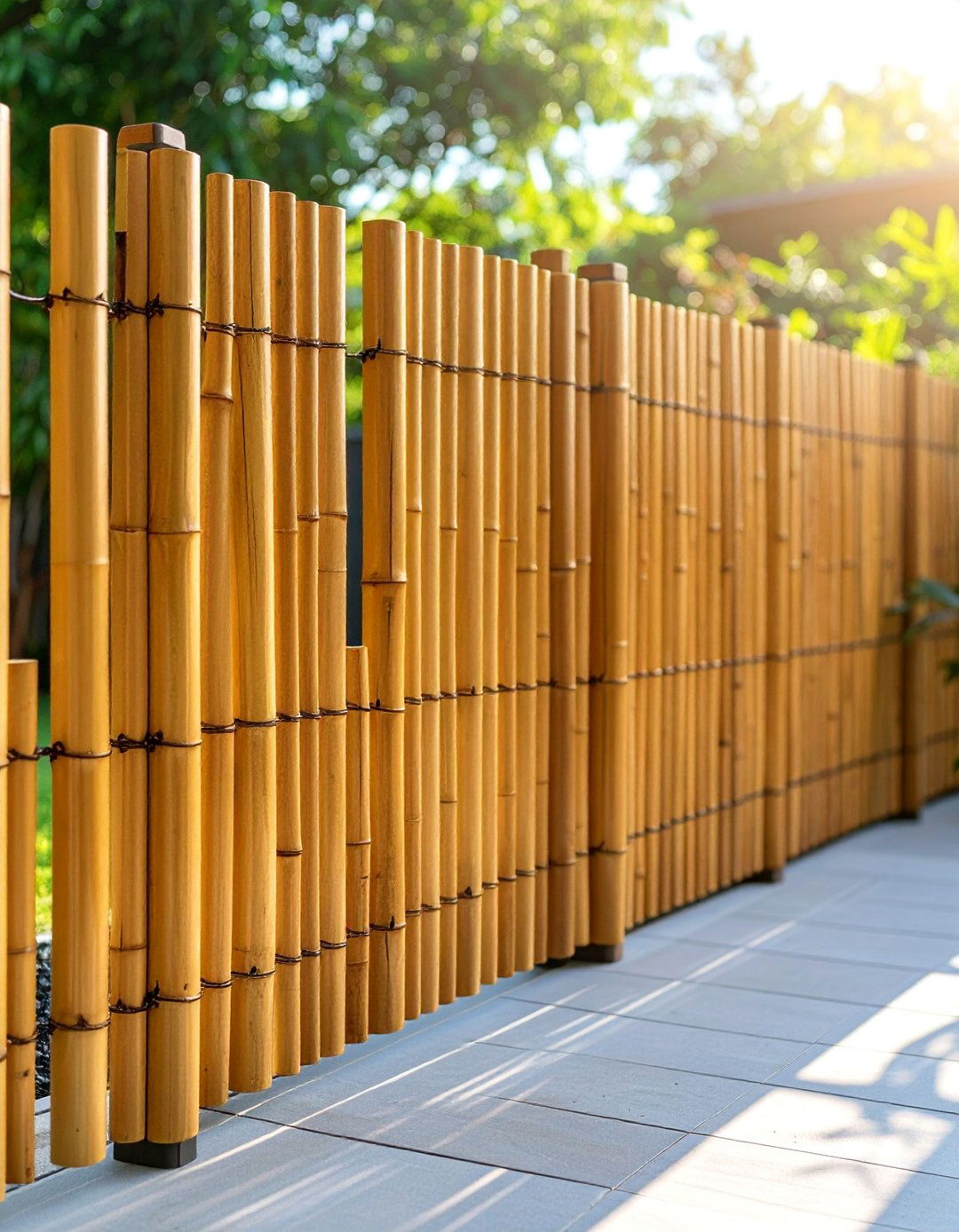
Transform your backyard into a tropical oasis using natural bamboo screening materials that provide excellent privacy while maintaining an airy, organic feel. Rolled bamboo fencing comes pre-assembled with galvanized wire connections, making installation straightforward when attached to existing wooden framework or metal posts. The natural golden tones and varied textures of bamboo poles create visual interest while effectively blocking sightlines from neighboring properties. Bamboo screens work particularly well around pools, patios, and meditation areas where you want privacy without feeling completely enclosed. The material's lightweight nature makes it easy to handle during installation, and its sustainable properties appeal to environmentally conscious homeowners. These screens also provide subtle sound dampening from traffic or neighborhood noise.
3. Living Wall Vertical Garden System
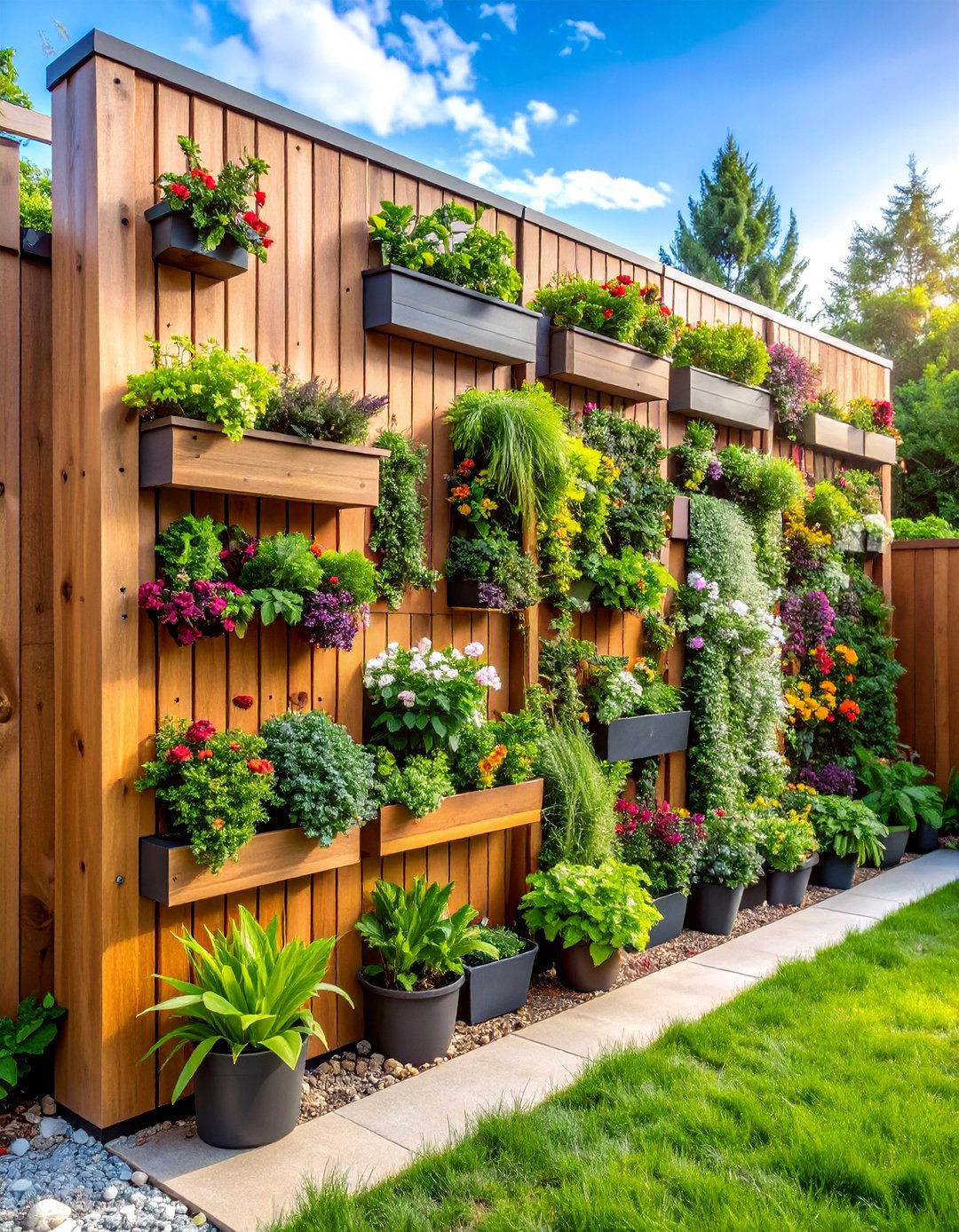
Create a stunning green privacy barrier using modular living wall systems that combine functionality with dramatic visual impact. These vertical gardens utilize specialized planting pockets or containers arranged in tiered configurations against existing fences or purpose-built frames. Fill each section with a mix of flowering plants, herbs, succulents, and trailing varieties to create a lush, multi-textured privacy screen that changes seasonally. Built-in irrigation systems ensure consistent moisture levels while making maintenance manageable. Living walls improve air quality, provide habitat for beneficial insects, and create a naturally cooling microclimate. Choose plants based on your climate zone and sun exposure, incorporating fragrant varieties like lavender or jasmine for additional sensory appeal. The system can expand gradually as budget allows.
4. Evergreen Privacy Hedge Border

Establish a permanent, natural privacy barrier using fast-growing evergreen shrubs that provide year-round screening with minimal maintenance requirements. Arborvitae varieties like 'Emerald Green' or 'Thuja Green Giant' create dense, formal hedges that can reach desired heights within three to five years. Plant specimens 3-4 feet apart in a straight line, ensuring adequate soil preparation and consistent watering during establishment. These living screens offer excellent wind protection, noise reduction, and wildlife habitat while requiring only annual pruning to maintain shape. Layering shorter shrubs in front creates depth and visual interest. The hedge naturally thickens over time, becoming increasingly effective at blocking views. Choose varieties suited to your hardiness zone for best long-term performance and cold tolerance.
5. Pergola with Retractable Privacy Screens
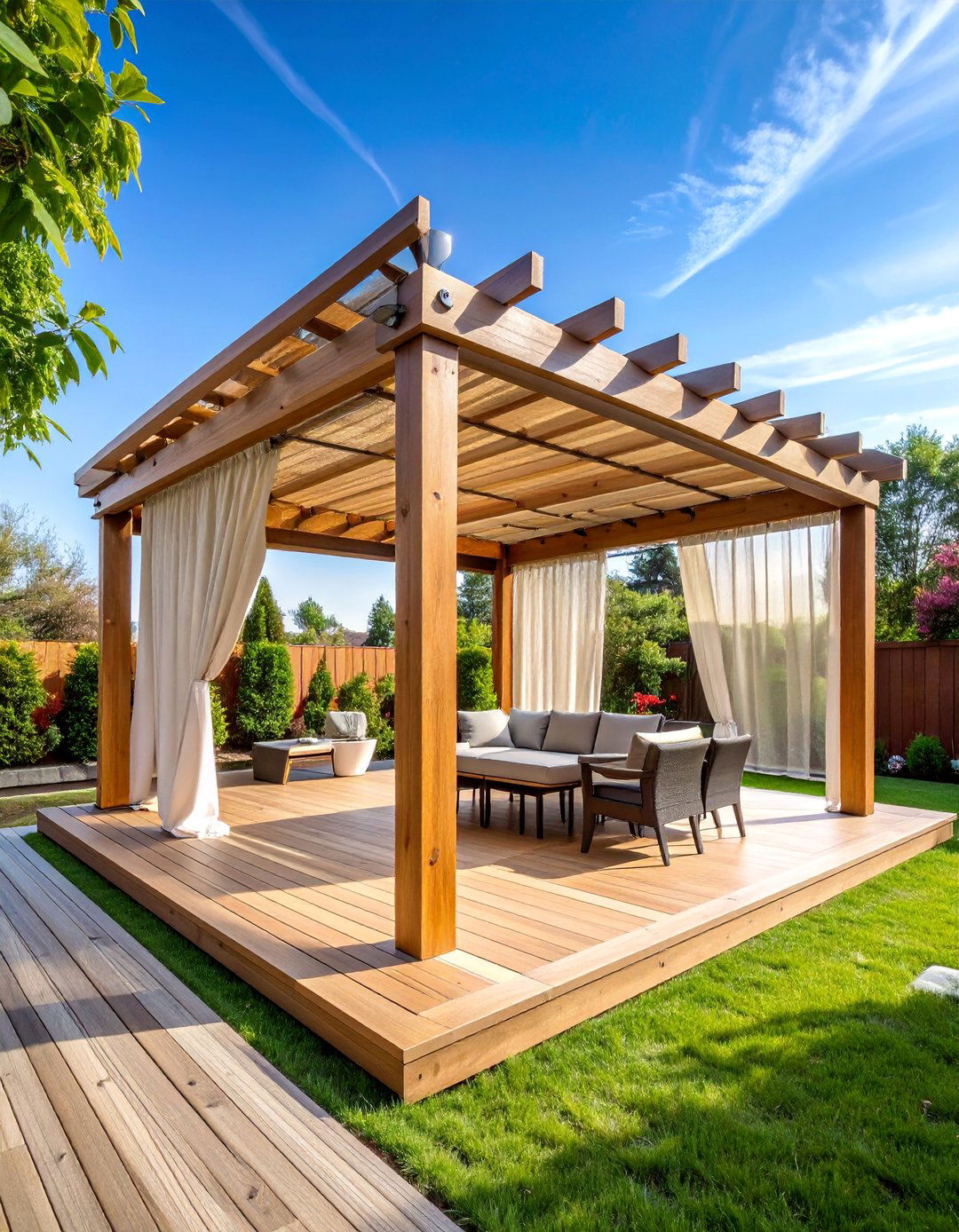
Design an elegant outdoor room using a pergola structure enhanced with retractable privacy screens that offer flexible screening options for different occasions. Aluminum or wooden pergola frames provide the basic structure, while motorized or manual privacy screens can be deployed when needed for intimate gatherings or relaxation. These screens come in various materials including weather-resistant fabrics, bamboo, or vinyl, allowing you to match your aesthetic preferences. The pergola's overhead structure can support climbing vines, string lights, or fabric canopies for additional ambiance. This solution works exceptionally well for hot tub areas, outdoor dining spaces, or reading nooks where occasional rather than permanent privacy is desired. The flexibility allows you to enjoy open views when desired while quickly creating seclusion.
6. Water Feature Privacy Barrier

Incorporate a substantial water feature like a tall fountain wall or cascading waterfall that serves dual purposes as both privacy screen and acoustic barrier. Stone or concrete water walls can reach 6-8 feet in height, effectively blocking views while creating soothing background sounds that mask neighborhood noise. Modern designs feature clean lines with water flowing down textured surfaces, while natural styles use stacked stones with planted accents. Built-in lighting transforms these features into stunning nighttime focal points. The sound of flowing water creates a zen-like atmosphere that enhances outdoor relaxation. Consider incorporating seating nearby to maximize enjoyment of the feature. Professional installation ensures proper drainage and pump systems for reliable operation. These features work well in contemporary and traditional landscape designs.
7. Outdoor Curtain Privacy Room

Create flexible privacy using weather-resistant outdoor curtains hung from pergolas, gazebos, or custom frameworks that can be opened or closed as needed. Marine-grade fabrics resist fading, mildew, and moisture while providing excellent coverage when privacy is desired. Install curtain tracks or grommeted panels that slide easily along rods, allowing quick adjustments based on wind conditions, sun angles, or privacy needs. Choose neutral colors that complement your outdoor furniture and landscape, or select bold patterns for dramatic impact. Curtains work particularly well for creating intimate dining areas, shielding hot tubs, or defining separate zones within larger backyards. Tie-backs allow curtains to be secured when not needed for screening. This solution offers the most flexibility for changing privacy requirements throughout different seasons and occasions.
8. Layered Landscape Privacy Design

Develop a sophisticated privacy strategy using multiple plant layers at varying heights to create natural screening that appears organic and intentional. Start with tall backdrop trees like oak or maple, then add medium-height shrubs like viburnum or hydrangea, finishing with lower perennials and ornamental grasses in front. This approach mimics natural forest edge environments while providing graduated privacy levels. Deciduous trees offer summer screening and winter light, while evergreen elements maintain year-round coverage. The layered design creates habitat for birds and beneficial insects while providing seasonal interest through changing foliage colors and flowering periods. Stagger plantings in irregular patterns rather than straight lines for the most natural appearance. This method requires more space but creates the most attractive and sustainable privacy solution.
9. Pallet Garden Privacy Screen
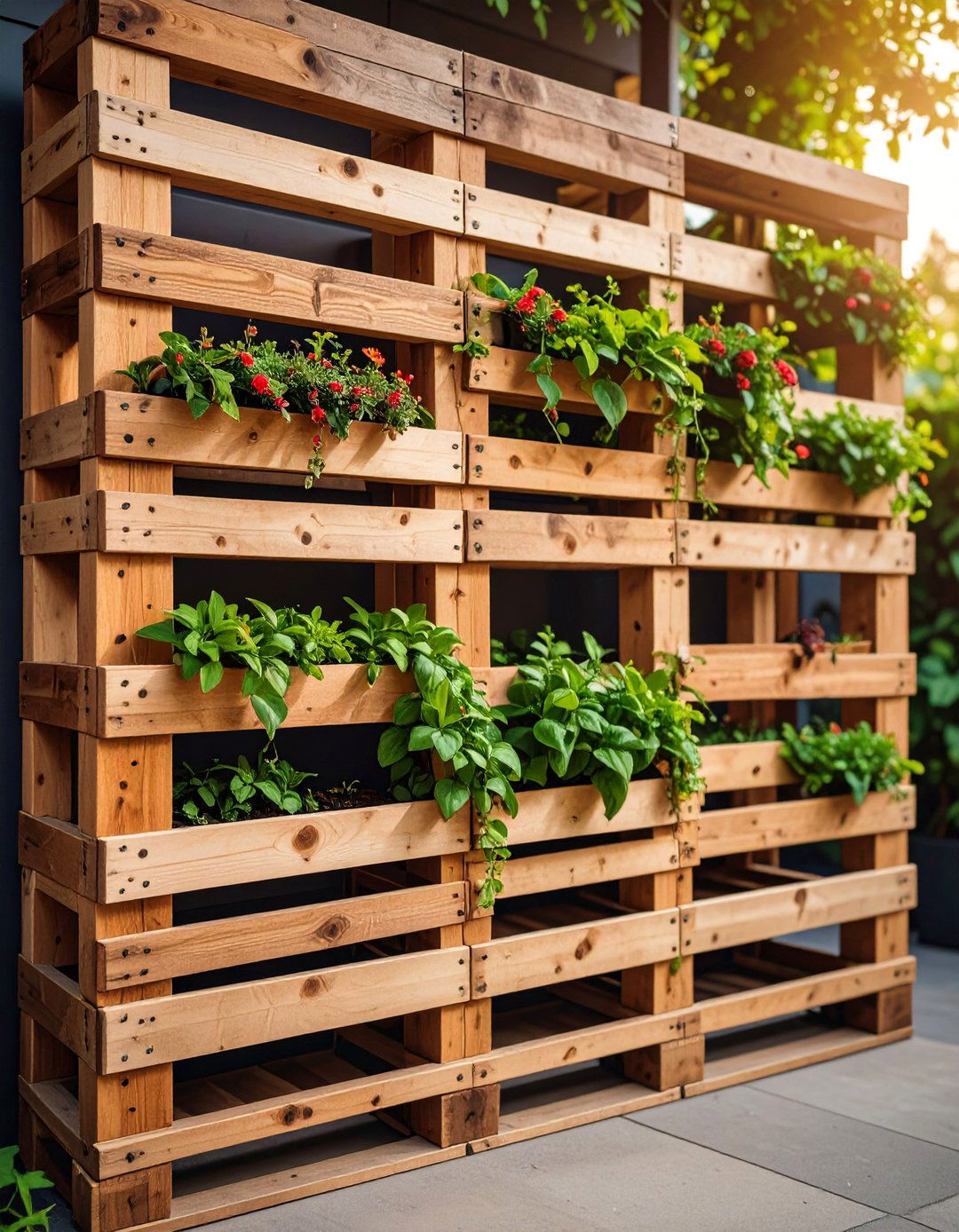
Repurpose wooden shipping pallets into cost-effective privacy screens that can be customized with plants, paint, or decorative elements for unique outdoor barriers. Sand and stain pallets to prevent splinters and enhance weather resistance, then position them vertically or horizontally depending on your desired aesthetic. Attach fabric, bamboo screening, or lattice panels between slats for additional coverage, or use the existing gaps to support climbing plants or hanging containers. Multiple pallets can be connected to create longer screening sections, while individual units work well for smaller areas or moveable privacy. This DIY approach allows complete customization of colors, textures, and plant combinations while keeping costs minimal. Pallet screens work well around trash storage areas, air conditioning units, or to define separate backyard zones.
10. Stone Wall with Climbing Vine Canopy
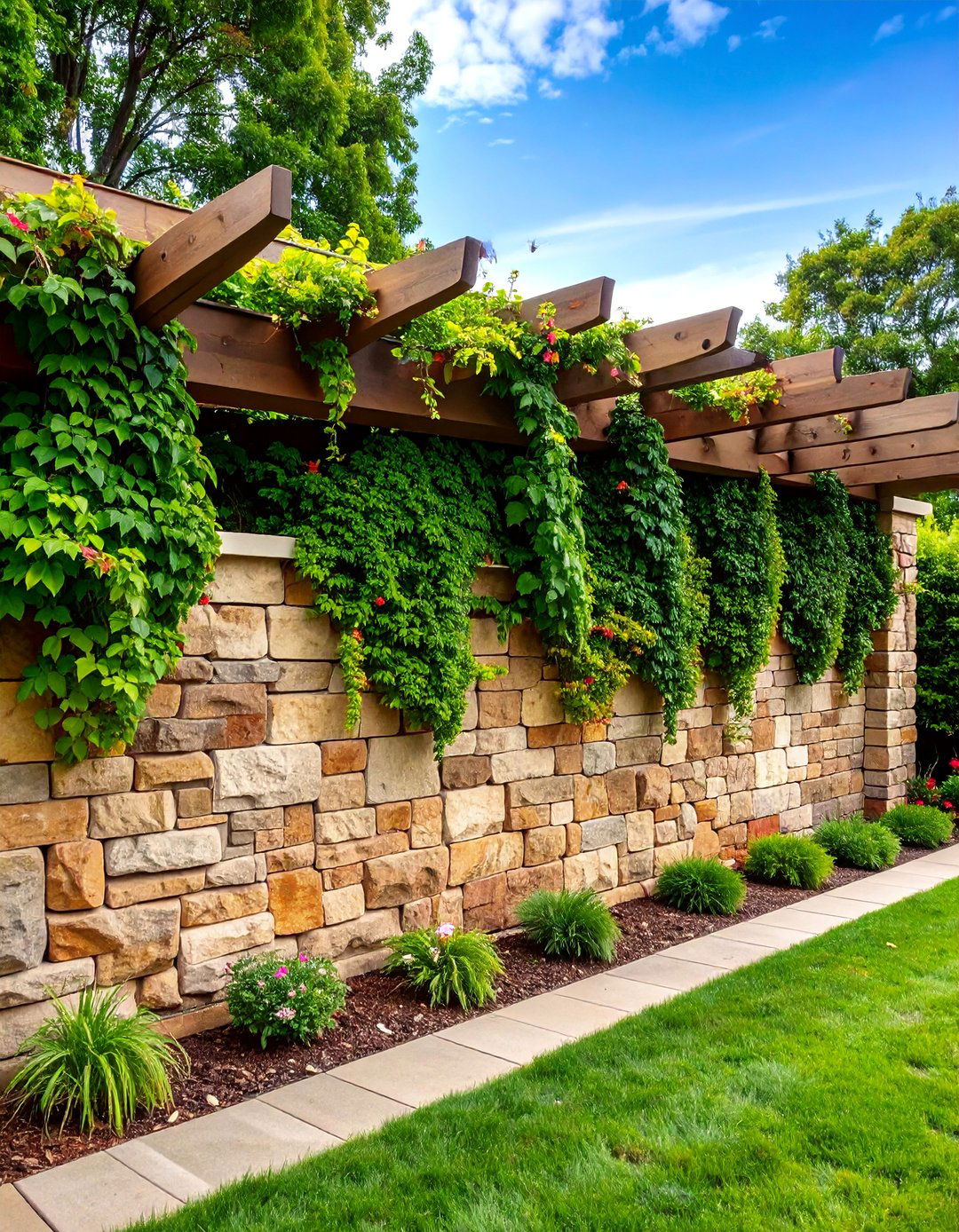
Construct a permanent privacy solution using natural stone or concrete block walls topped with support structures for climbing plants that soften the hardscape appearance. The solid wall portion provides immediate privacy up to 4-5 feet, while overhead trellises or wire systems support vigorous climbers like wisteria, grape vines, or climbing roses that complete the screening. This combination offers the security and permanence of masonry construction with the beauty and seasonal change of living plants. Stone walls provide wind protection, noise reduction, and thermal mass that moderates temperature swings. The climbing plants create overhead canopy that enhances privacy from second-story windows while providing seasonal fragrance and color. Choose wall materials that complement your home's architecture and regional stone traditions for the most attractive integration.
11. Gazebo Privacy Sanctuary
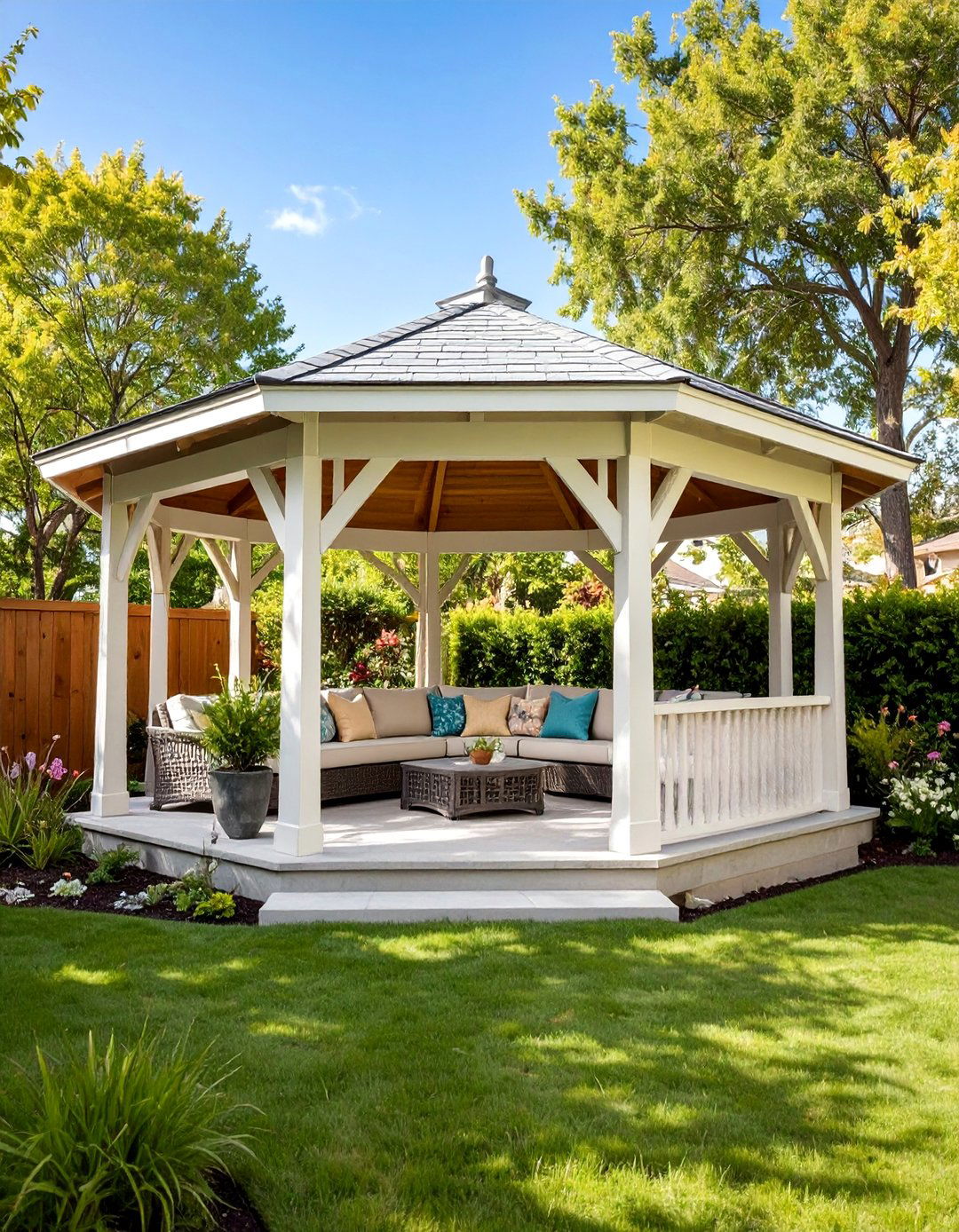
Install a substantial gazebo structure with partial or complete wall panels that creates a dedicated private outdoor room for relaxation and entertainment. Modern gazebos offer various privacy configurations from open-air designs to fully enclosed spaces with removable panels for seasonal flexibility. Hard-top versions with metal or polycarbonate roofing provide weather protection, while soft-top styles with fabric canopies offer lighter, more temporary solutions. Surround the gazebo with foundation plantings, decorative screens, or water features to enhance the sense of enclosure. Interior furnishings can include comfortable seating, outdoor dining sets, or even hot tubs for ultimate luxury. Integrated lighting and ceiling fans extend usability into evening hours. This approach works well when you want a fully private retreat area while maintaining open views in other backyard areas.
12. Lattice Trellis Living Screen
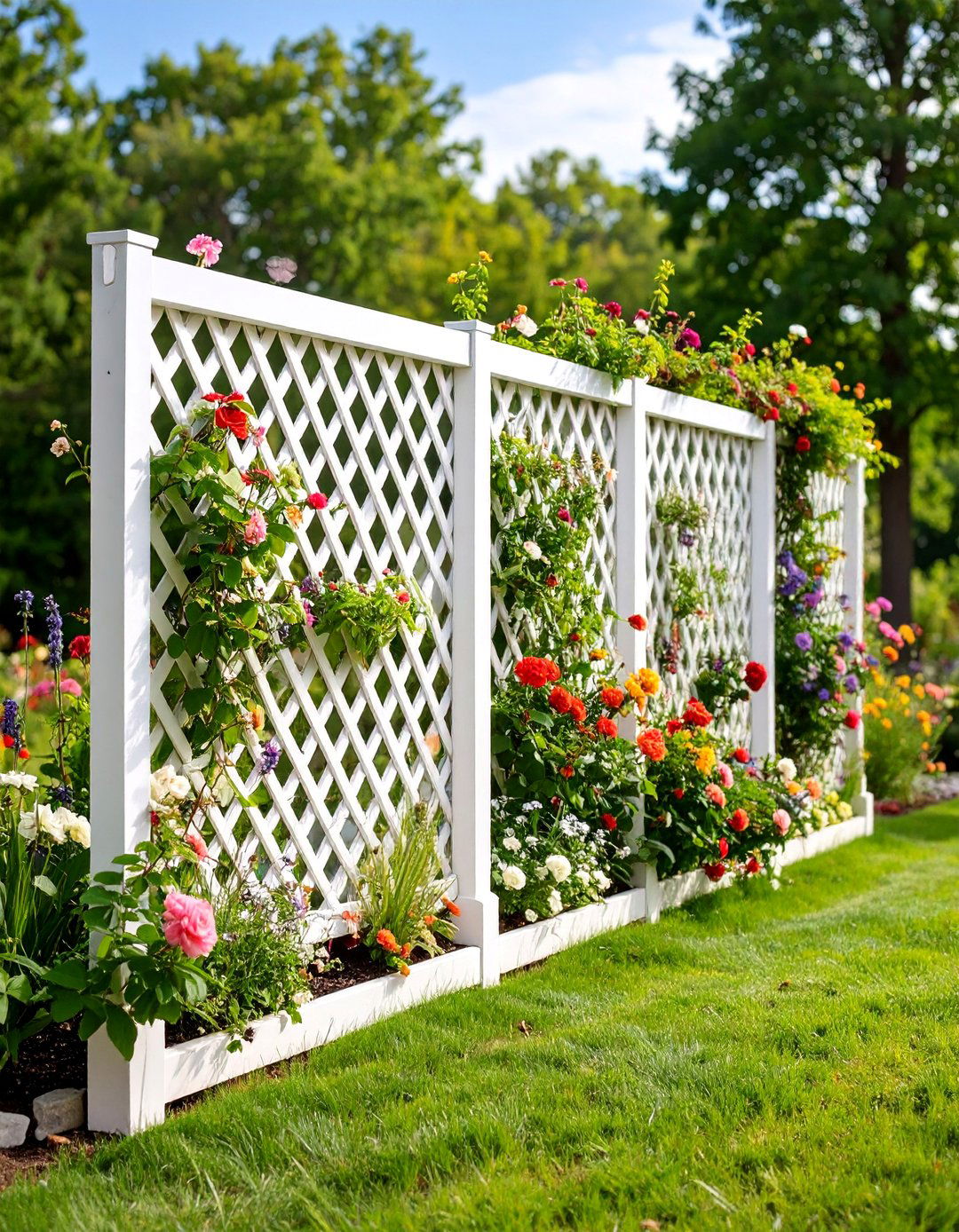
Create an attractive privacy solution using wooden or vinyl lattice panels that serve as both immediate screening and support structures for climbing plants. Install lattice sections between posts or attach them to existing fences to create instant geometric patterns while providing framework for plant growth. Popular climbing plants for lattice include clematis, honeysuckle, ivy, and annual flowering vines that quickly cover the structure. The diagonal or square lattice patterns allow filtered light and air circulation while maintaining privacy. Painting lattice in colors that complement your home creates visual continuity, while natural wood tones blend with landscape elements. This solution offers immediate privacy that improves over time as plants mature. Different lattice patterns and climbing plant combinations allow customization for various garden styles from cottage to contemporary designs.
13. Container Garden Privacy Wall

Design a moveable privacy solution using large planters filled with tall shrubs, ornamental grasses, or small trees that can be rearranged as needed for different privacy configurations. Choose containers that complement your outdoor décor while being large enough to support substantial plant growth – generally 24 inches wide minimum for most privacy plants. This approach works excellently for renters, seasonal residents, or homeowners who like to change their landscape arrangements. Evergreen shrubs like boxwood or yew provide year-round screening, while seasonal annuals offer changing color displays. Rolling planters on casters make reconfiguration easy for parties or seasonal storage. Group containers in staggered arrangements rather than straight lines for the most natural appearance. This method allows complete flexibility while avoiding permanent landscape commitments or potential property restriction issues.
14. Horizontal Slat Modern Fence

Construct a contemporary privacy fence using horizontal wooden slats that create clean lines and sophisticated screening perfect for modern landscape designs. Cedar, ipe, or composite materials work well for horizontal applications, with slats typically spaced with small gaps for air circulation and visual interest. The horizontal orientation makes yards appear wider while providing excellent privacy when slats are positioned at appropriate heights and spacing. Alternate slat depths or incorporate different widths for added visual texture without compromising screening effectiveness. This style complements modern architecture and can be stained or painted to match home exteriors. Integrated lighting strips between slats create dramatic nighttime effects. The horizontal lines work particularly well on sloped sites where the fence can follow grade changes while maintaining consistent privacy levels.
15. Mixed Material Contemporary Screen
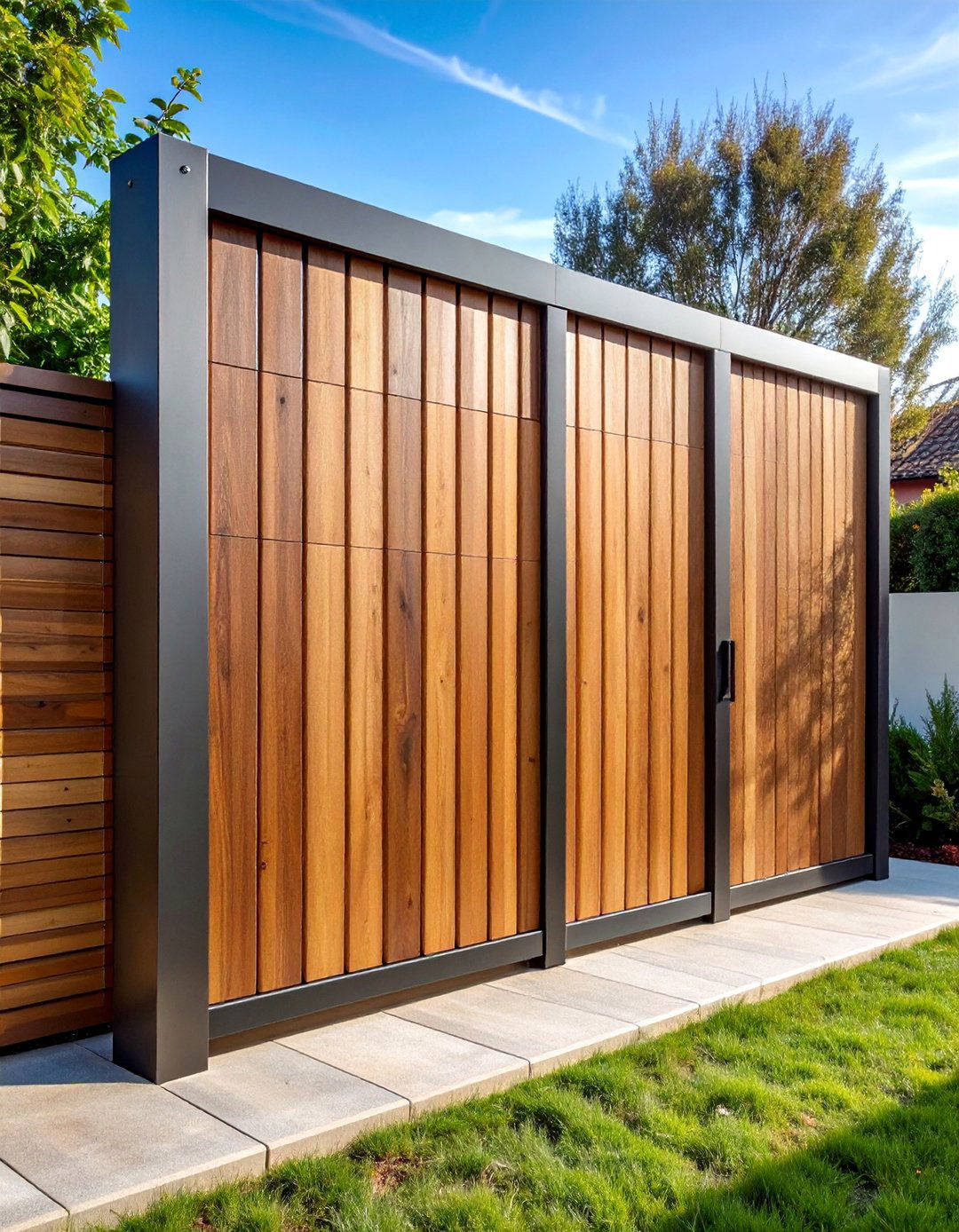
Combine different screening materials like wood, metal, and fabric panels to create visually interesting privacy barriers that add architectural elements to outdoor spaces. Alternating sections of cedar slats with powder-coated aluminum panels creates contrast while maintaining consistent screening height and effectiveness. Incorporate translucent materials like frosted acrylic or fabric panels for areas where light transmission is important while preserving privacy. This approach allows customization of colors, textures, and opacity levels to match specific site conditions and aesthetic preferences. Mixed materials can address different functional needs within the same screening system – solid sections for complete privacy and perforated areas for air circulation. The varied textures and materials create visual interest that becomes a landscape feature rather than just functional screening.
16. Fast-Growing Tree Privacy Border
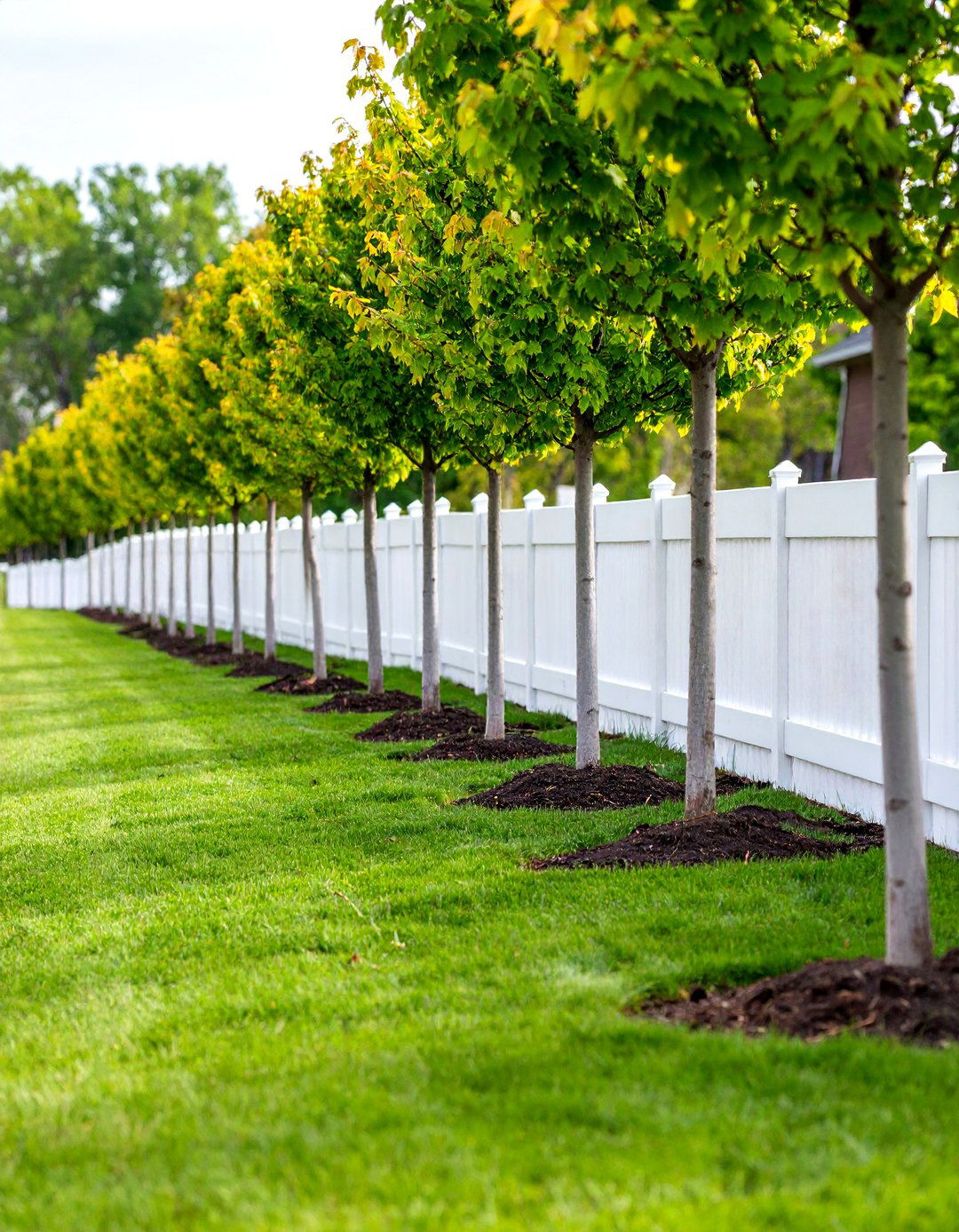
Establish natural privacy using rapidly-growing tree species that provide substantial screening within 3-5 years while creating long-term landscape value. Hybrid poplars, willows, and fast-growing maples can reach 15-20 feet quickly when properly planted and maintained. Space trees 8-12 feet apart for eventual canopy overlap while allowing adequate root development. This approach requires patience but creates the most attractive and sustainable privacy solution. Fast-growing trees also provide significant environmental benefits including air purification, carbon sequestration, and wildlife habitat. Choose species appropriate for your climate zone and soil conditions, ensuring adequate irrigation during establishment. The mature canopy provides privacy from second-story windows while creating pleasant filtered shade. Underplant with shrubs and perennials for complete screening and year-round interest.
17. Outdoor Privacy Cabana
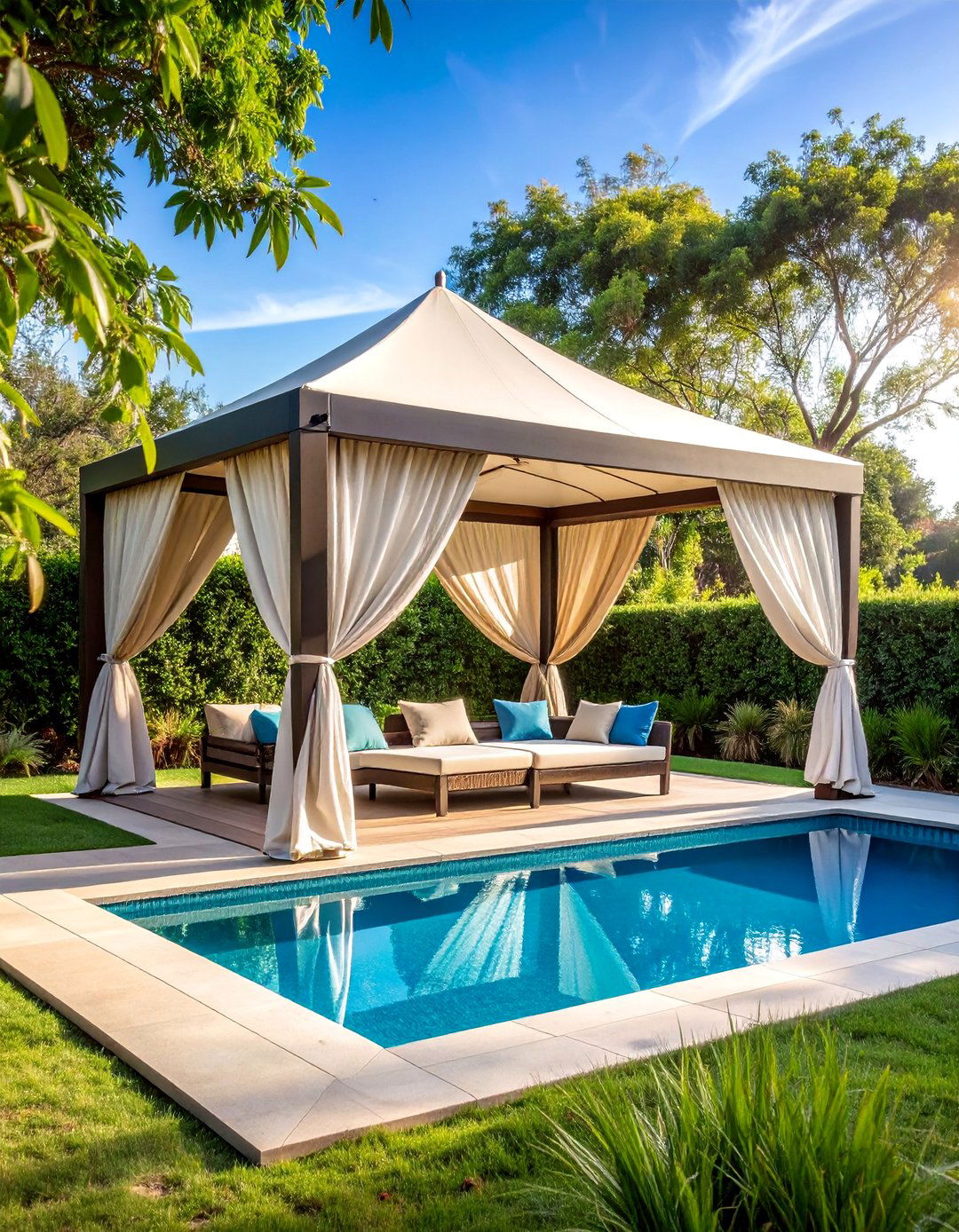
Create an intimate backyard retreat using a canvas or fabric cabana structure that provides complete privacy while maintaining a resort-like atmosphere. Modern outdoor cabanas feature weather-resistant materials, mosquito netting, and privacy curtains that can be adjusted based on conditions and desired openness. These structures work excellently around pools, hot tubs, or outdoor dining areas where temporary but complete privacy is desired. Many models include integrated lighting, ceiling fans, and mounting points for decorative elements. The fabric elements are typically removable for cleaning or seasonal storage. This solution offers the most luxurious privacy experience while requiring minimal permanent site modifications. Choose fabrics and frame materials that complement your existing outdoor furniture and architectural style for the best integration.
18. Decorative Metal Screen Panel System
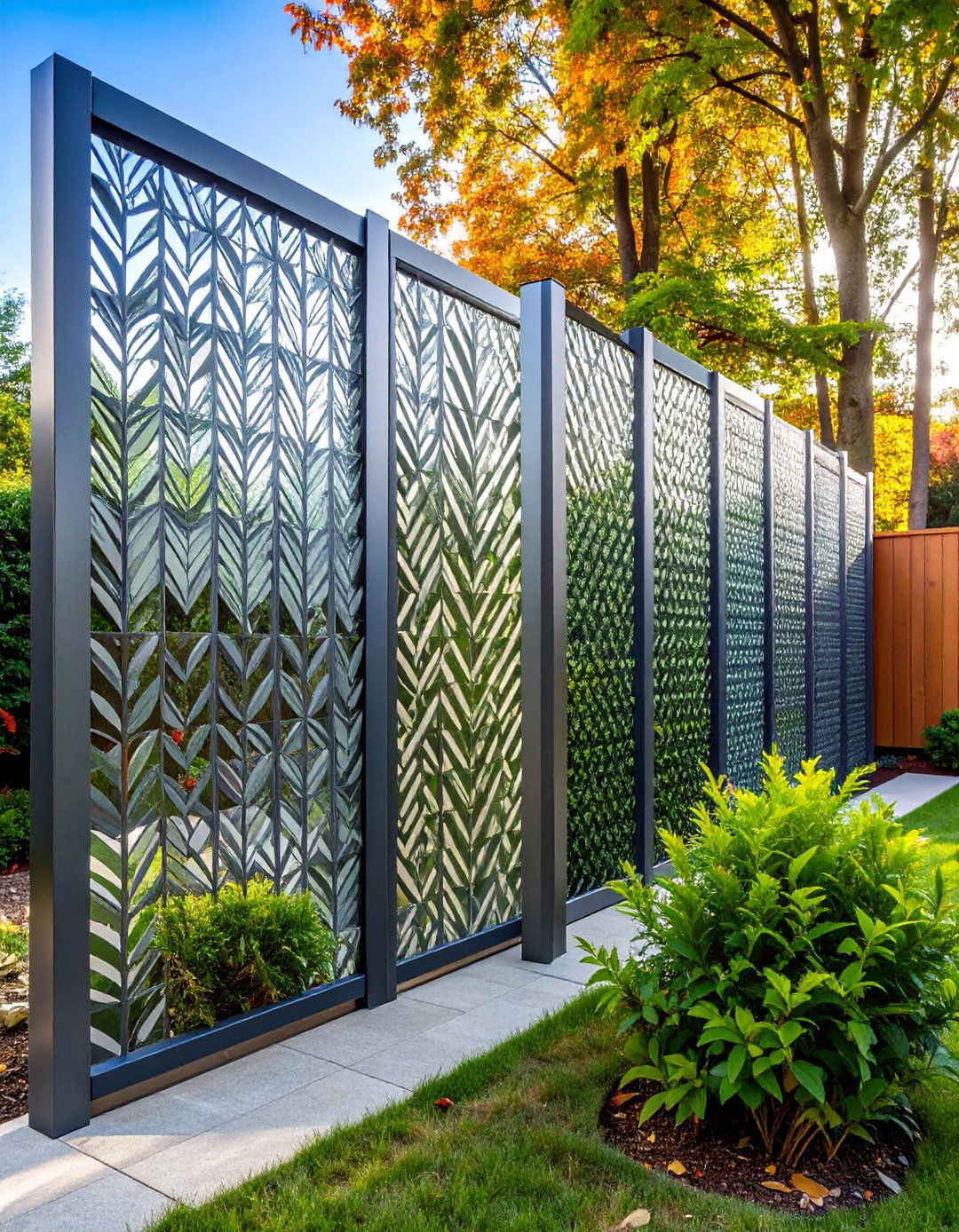
Install artistic metal privacy screens that combine functional screening with sculptural design elements that enhance rather than hide your outdoor space. Laser-cut aluminum or steel panels feature patterns ranging from geometric designs to natural motifs like leaves or branches. These screens provide excellent privacy while allowing air circulation and creating interesting shadow patterns when backlit. Weather-resistant powder coating ensures long-term durability with minimal maintenance requirements. Multiple panels can create long screening runs, while individual panels work well as accent features or partial barriers. The industrial aesthetic complements modern architecture and contemporary landscape designs. Integrated lighting can highlight the decorative patterns for dramatic nighttime effects. This approach transforms necessary privacy screening into attractive landscape art that adds value and visual interest to outdoor spaces.
19. Garden Shed Privacy Anchor
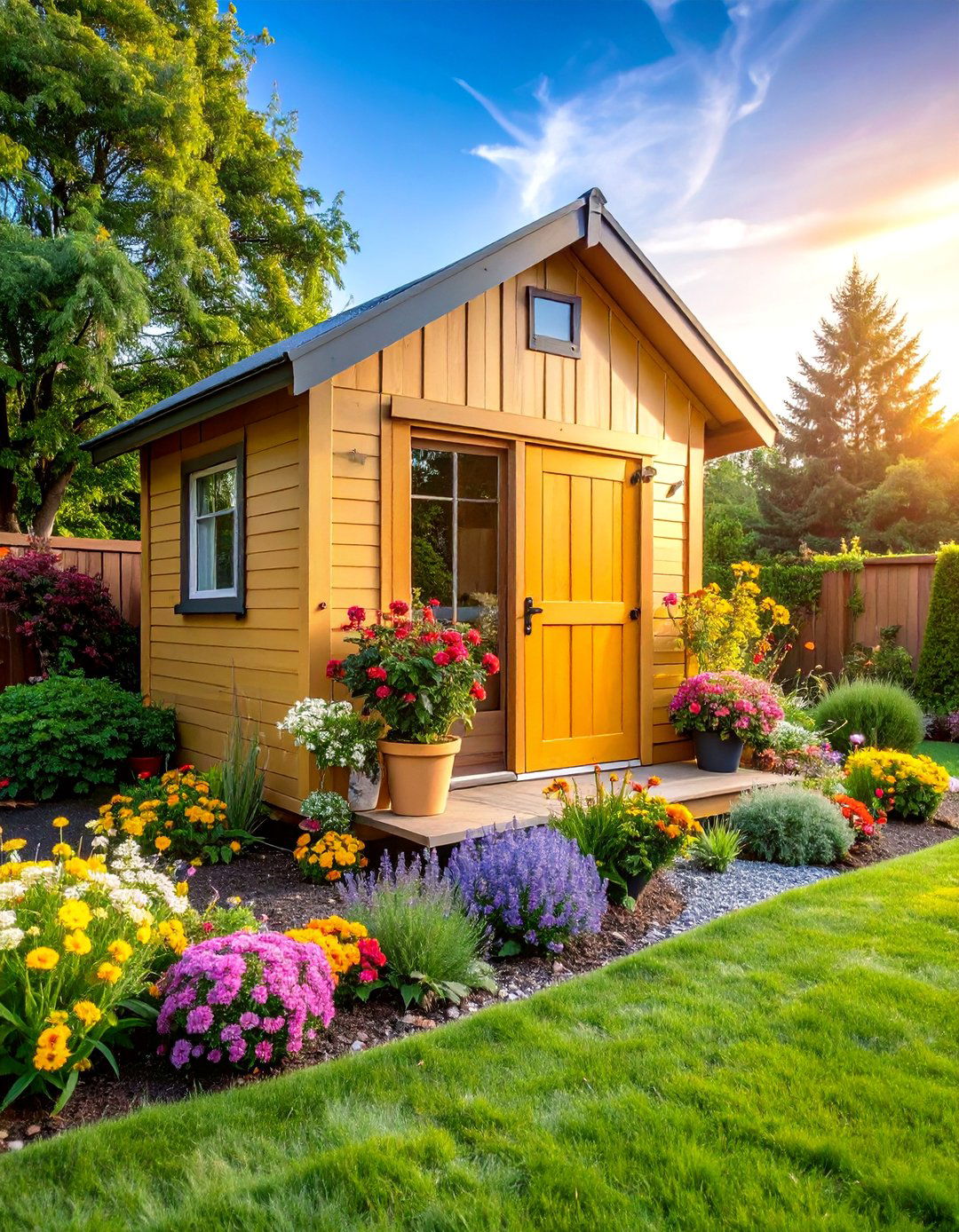
Position a substantial storage shed or garden building strategically to create privacy while adding functional storage space for outdoor equipment and tools. Modern shed designs offer attractive exteriors that complement landscape architecture while providing the mass needed for effective visual screening. The shed placement blocks sightlines from neighboring properties while creating opportunities for additional privacy elements like attached pergolas or screening panels. Surround the structure with foundation plantings to integrate it naturally into the landscape design. This dual-purpose approach maximizes the value of yard structures while addressing privacy needs efficiently. Choose shed styles and materials that coordinate with your home's architecture for the best visual integration. The solid structure provides immediate privacy that can be enhanced with additional screening elements as needed.
20. Raised Garden Bed Privacy Barrier

Construct elevated planting beds that serve as both productive garden space and natural privacy screening for ground-level views. Build beds 3-4 feet high using stone, timber, or concrete blocks, then fill with quality soil for growing tall vegetables, herbs, or ornamental plants. This approach combines food production with privacy screening while creating attractive landscape features. Climbing structures within beds support beans, peas, or decorative vines that increase screening height. The raised design improves drainage and soil conditions while making garden maintenance more comfortable. Multiple beds can create privacy corridors or define separate outdoor spaces. This solution appeals to homeowners interested in sustainable living and organic food production while addressing privacy needs. The productivity aspect helps justify the initial construction investment while providing ongoing benefits.
21. Ornamental Grass Privacy Buffer
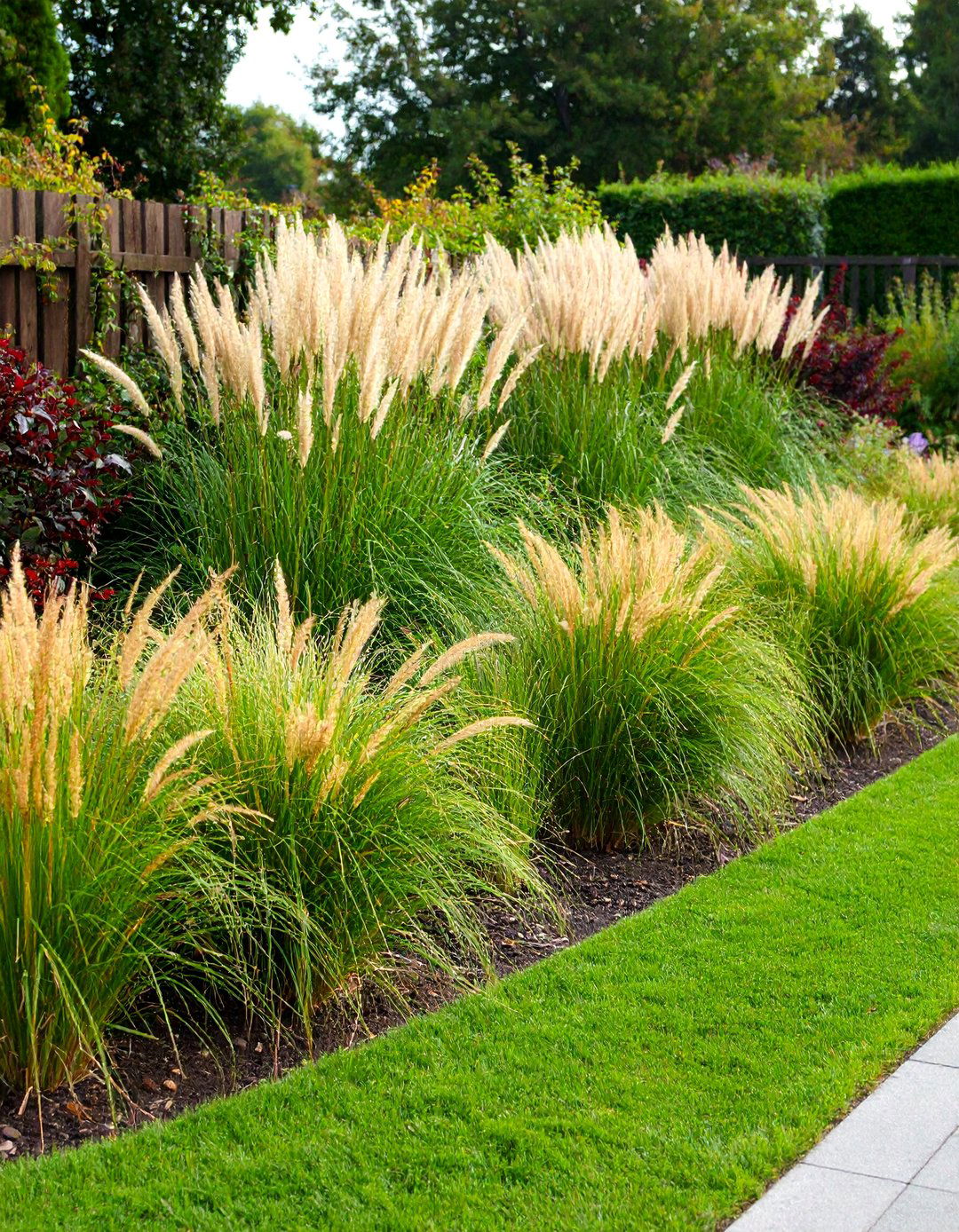
Plant large ornamental grasses in mass groupings to create flowing, natural-looking privacy screens that move gracefully in breezes while providing effective visual barriers. Species like miscanthus, fountain grass, or bamboo grass reach substantial heights while maintaining attractive form throughout growing seasons. These grasses offer four-season interest with summer growth, fall color changes, winter structural elements, and spring renewal cycles. The informal appearance softens property lines while providing excellent screening when planted densely. Ornamental grasses require minimal maintenance once established and provide habitat for beneficial insects and birds. Choose clumping rather than spreading varieties to maintain control over long-term growth patterns. The natural movement and seasonal changes create dynamic privacy barriers that feel alive and integrated with natural landscape rhythms.
22. Multi-Level Deck Privacy Integration
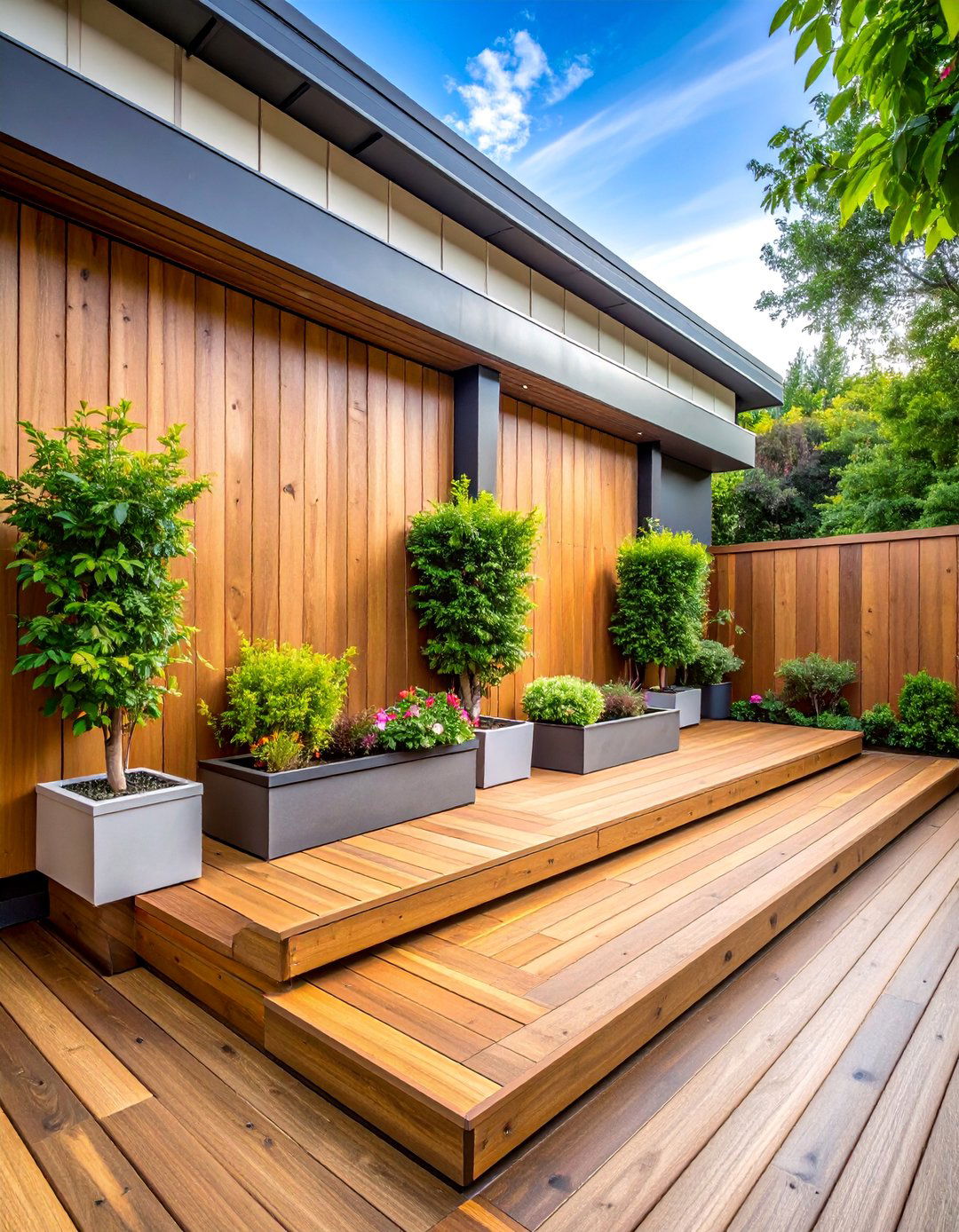
Design deck privacy solutions that work with elevation changes to maximize screening effectiveness while maintaining architectural continuity with your home's structure. Elevated decks can incorporate privacy walls, pergolas, or screening systems that block views from neighboring second-story windows while preserving attractive views in other directions. The elevated position allows privacy barriers to be lower while remaining effective, reducing visual impact on the landscape. Integrate planters, built-in seating, or storage elements with privacy features for maximum functionality. Different privacy levels can be used for various deck areas – complete screening for hot tubs and partial barriers for dining areas. Use materials that match deck construction for visual consistency. This approach creates private outdoor rooms at different levels while maintaining the open feeling that makes decks attractive.
23. Retractable Fabric Panel System

Install a flexible privacy system using retractable fabric panels that can be extended or retracted based on changing privacy needs throughout the day. Track-mounted systems allow panels to slide along rails, providing variable screening from complete openness to full privacy coverage. Choose fade-resistant outdoor fabrics in colors and patterns that complement your outdoor décor while providing the desired level of opacity. This system works excellently for areas where privacy needs change based on activities, weather conditions, or neighboring property usage patterns. The retractable feature allows maximum flexibility while preserving attractive views when privacy isn't needed. Professional installation ensures smooth operation and proper tensioning. The fabric elements can be removed for cleaning or winter storage, extending system life while reducing maintenance requirements.
24. Repurposed Door Privacy Feature

Transform salvaged doors, shutters, or architectural elements into unique privacy screens that add character and functionality to outdoor spaces. Vintage doors can be mounted on posts or frames to create attractive barriers with built-in visual interest and historical charm. Weather-resistant finishes protect wood while enhancing natural patina and character marks. Multiple doors can create longer screening sections, while individual pieces work well as accent features or garden art. This approach appeals to homeowners interested in sustainable design and unique landscape elements. The architectural details of vintage doors add sophistication that standard screening materials cannot match. Paint or stain treatments can coordinate doors with existing outdoor elements while preserving their distinctive character. This solution combines affordability with one-of-a-kind aesthetic appeal.
25. Terraced Slope Privacy Garden

Design a multi-level privacy solution on sloped terrain using terraced planting areas that create natural screening while preventing erosion and maximizing planting space. Retaining walls at different levels support diverse plant communities from groundcovers to small trees, creating layered privacy barriers that appear natural and intentional. Each terrace level can feature different plant types – tall shrubs on upper levels for overhead screening and lower perennials on bottom tiers for ground-level privacy. The terraced design allows better water management and creates microclimates suitable for different plant species. Stone or timber retaining walls add structural interest while providing necessary slope support. This approach transforms challenging slope conditions into attractive privacy features while adding significant landscape value and preventing soil erosion problems.
Conclusion:
Creating backyard privacy requires thoughtful consideration of your specific needs, budget, and aesthetic preferences. Whether you choose natural solutions like hedges and living walls, structural options like fences and pergolas, or creative DIY approaches using repurposed materials, the key is selecting solutions that complement your outdoor lifestyle. The most successful privacy designs combine multiple strategies – perhaps evergreen screening for year-round coverage enhanced by seasonal plantings for color and texture. Remember that privacy solutions can be implemented gradually, allowing you to spread costs over time while observing how different approaches work in your specific setting. With careful planning and creative implementation, your backyard can become the private sanctuary you desire.



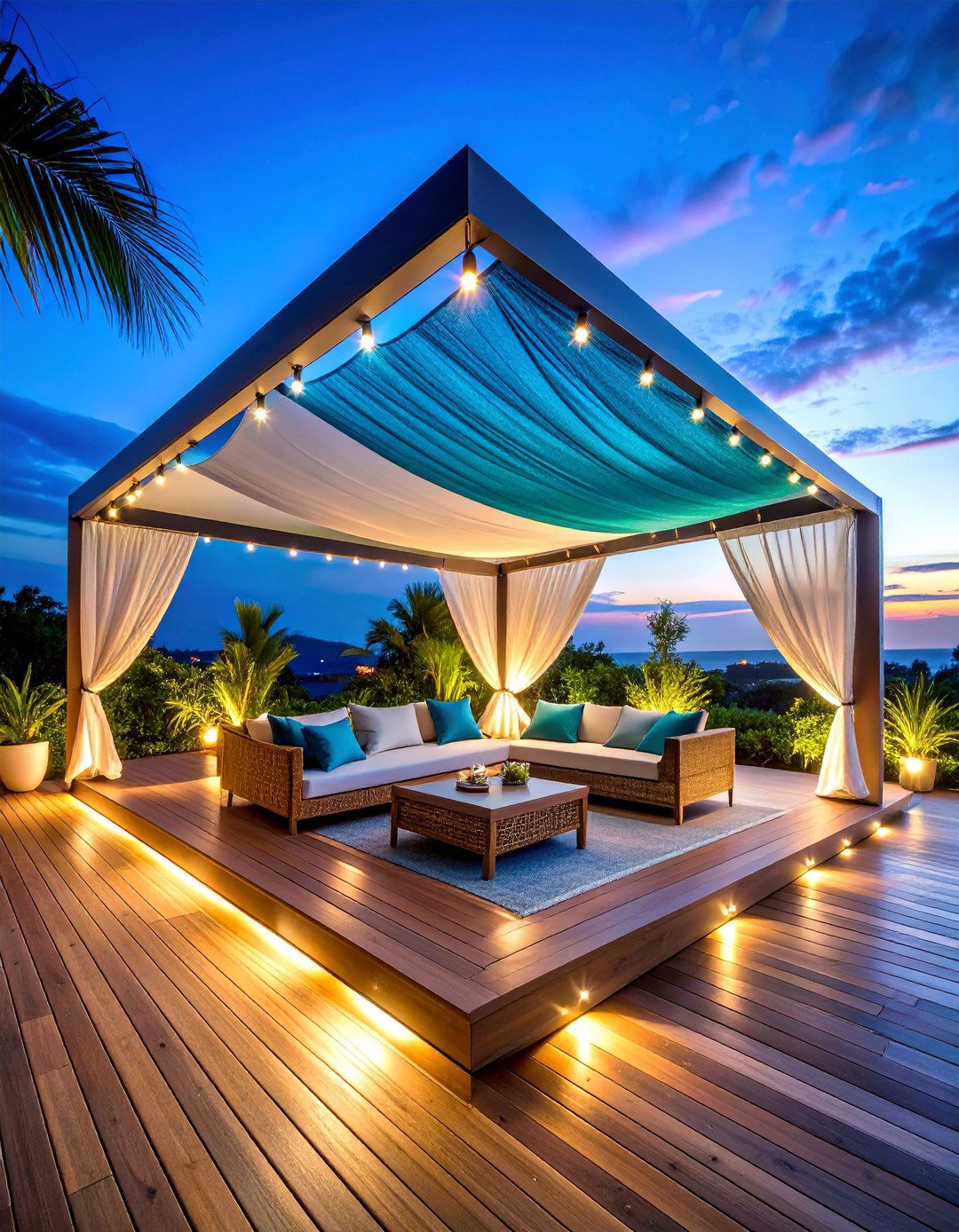



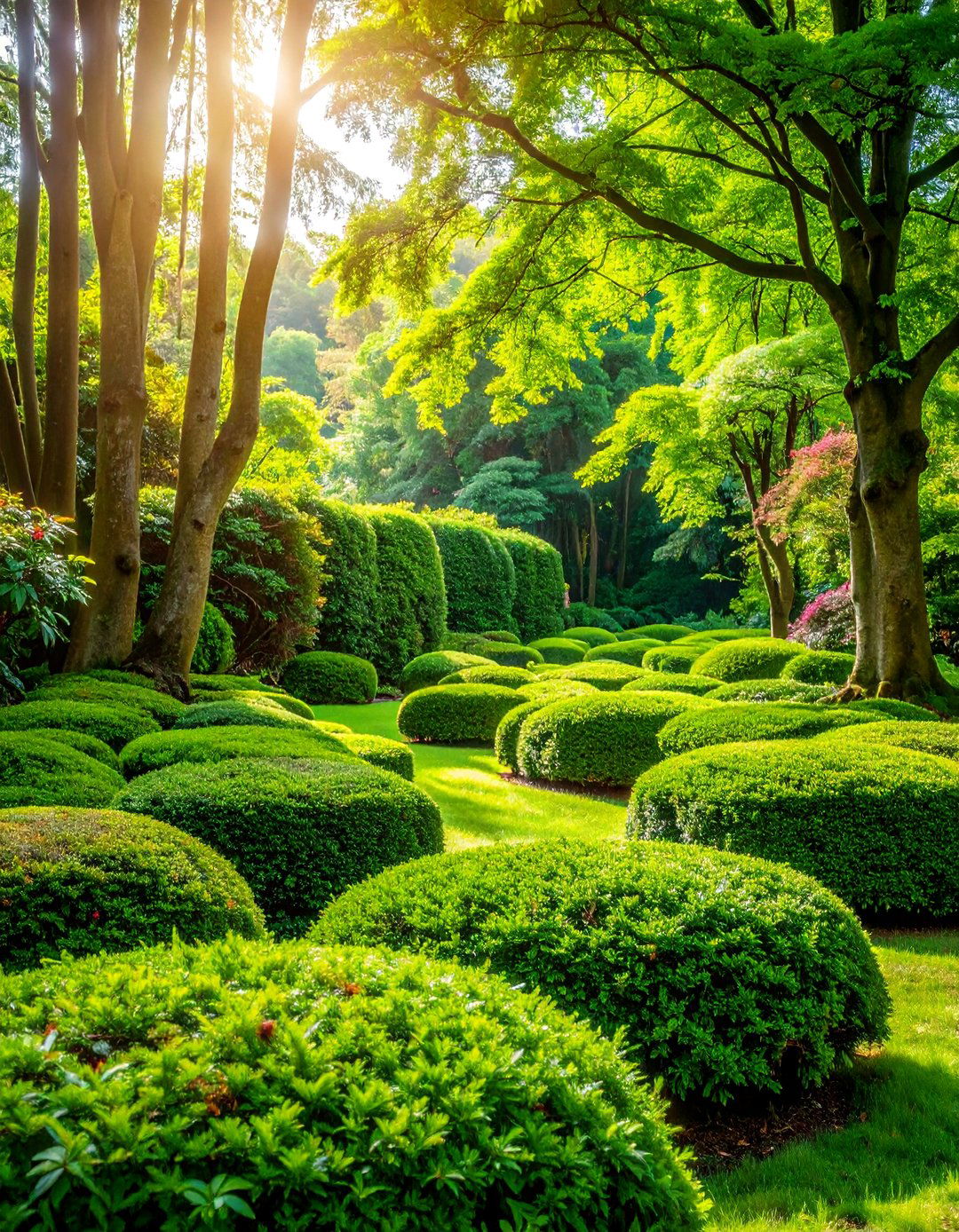

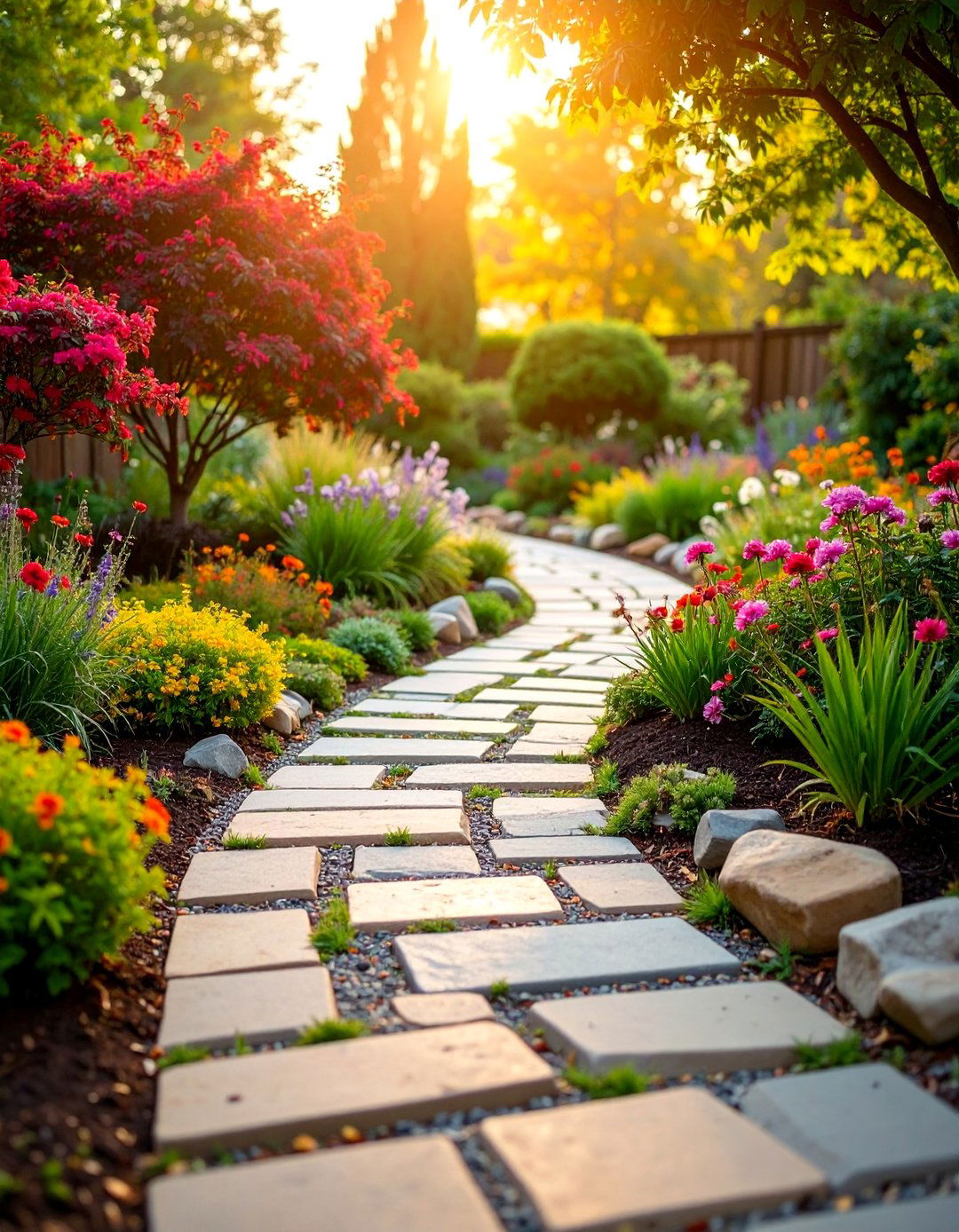


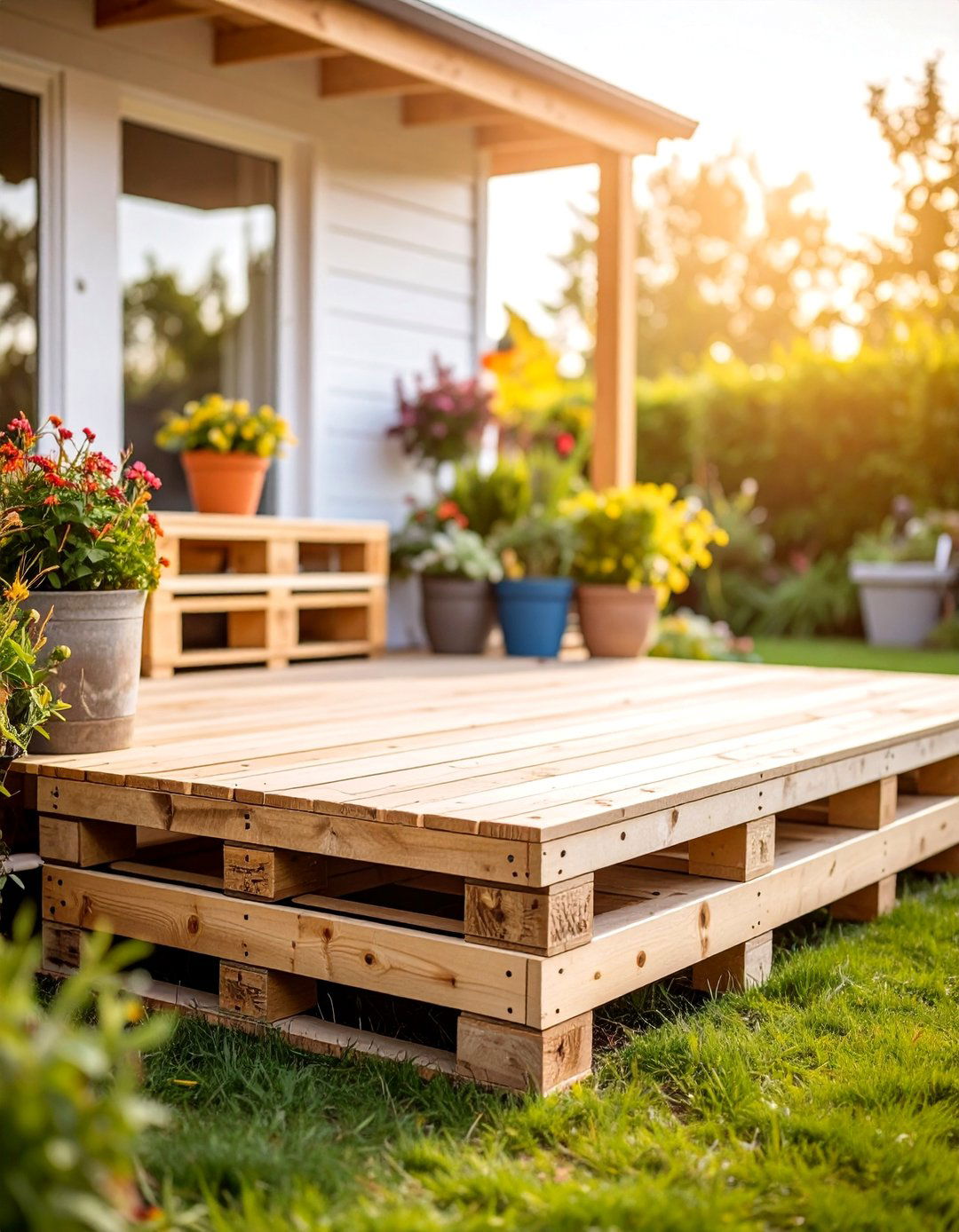

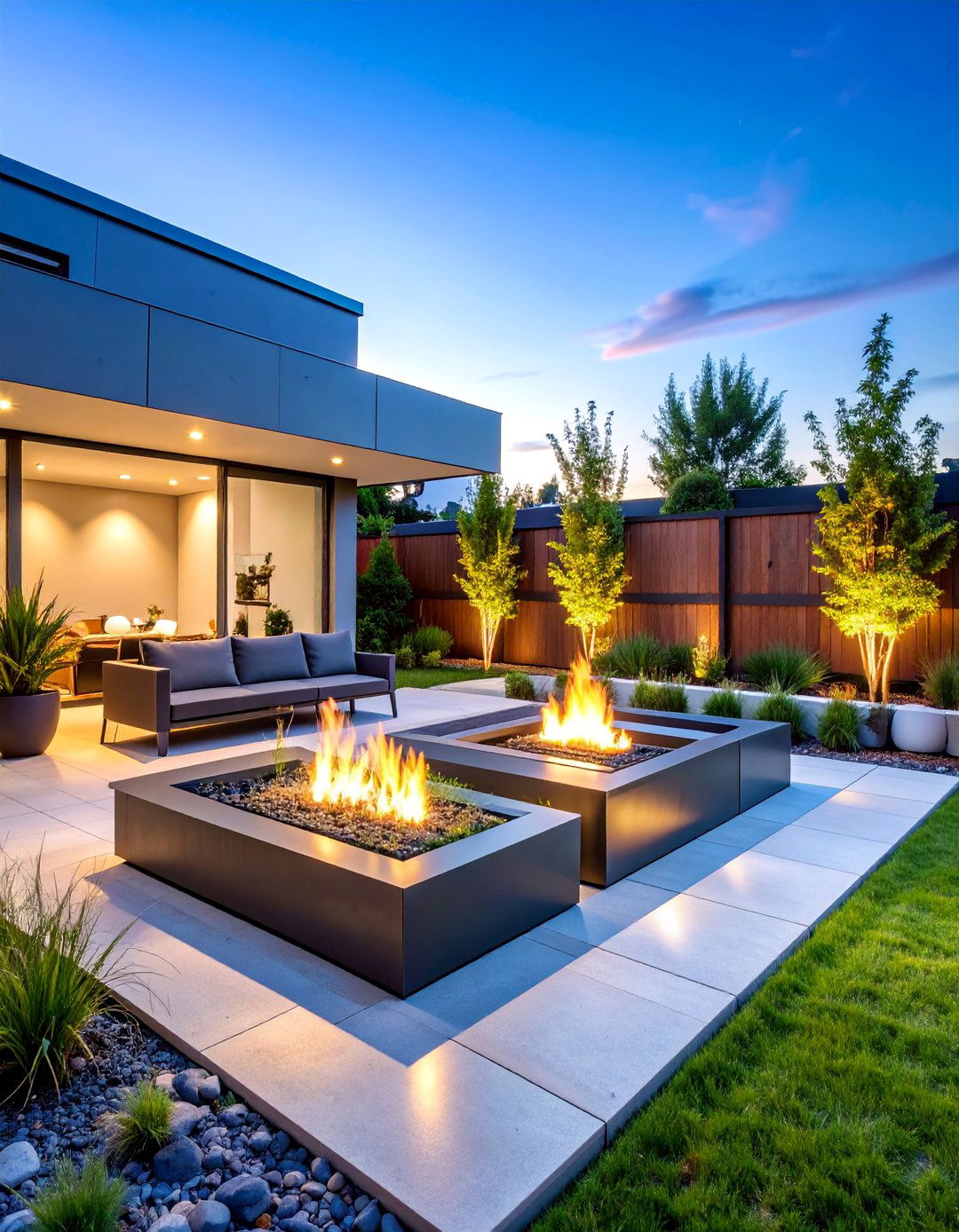

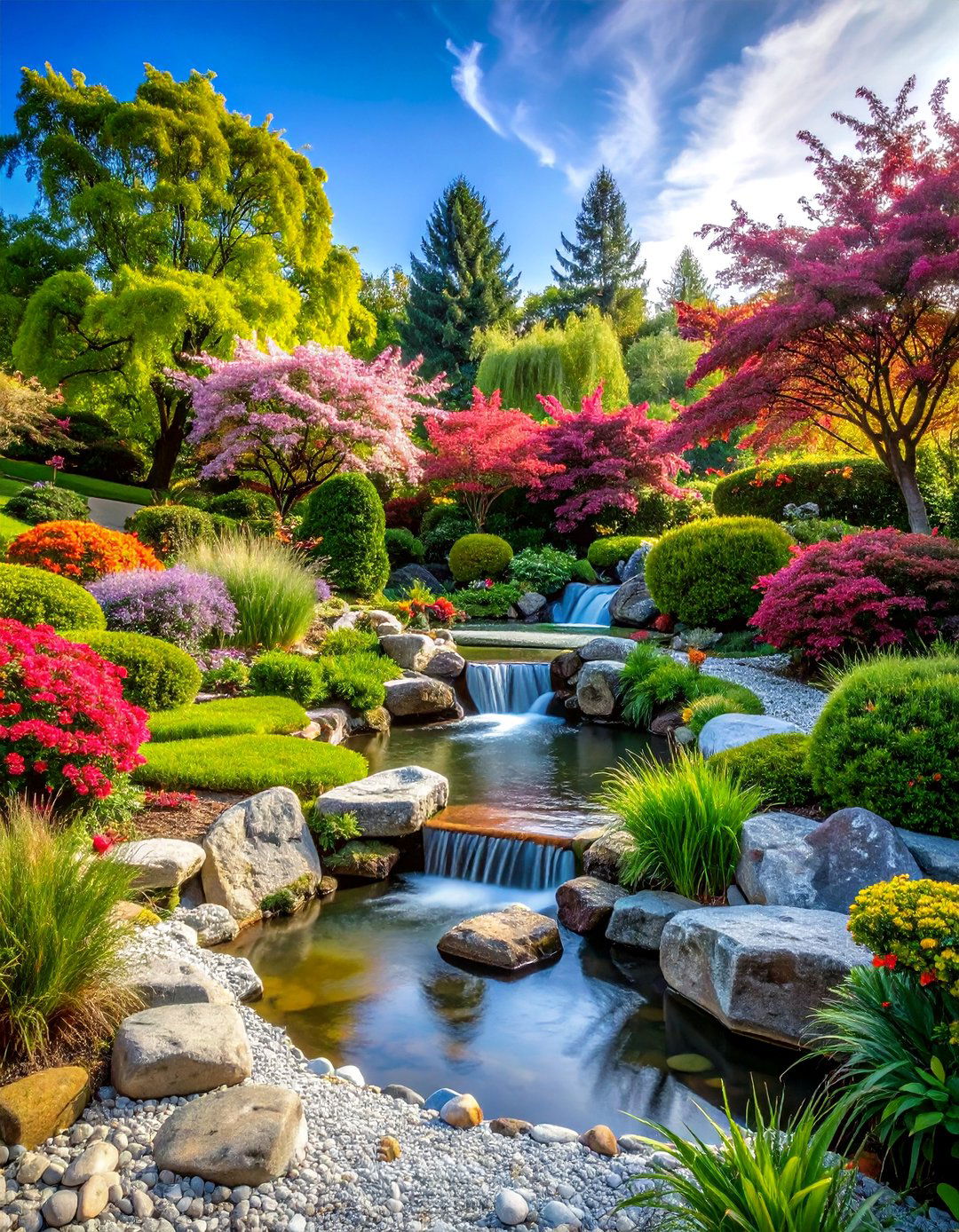
Leave a Reply